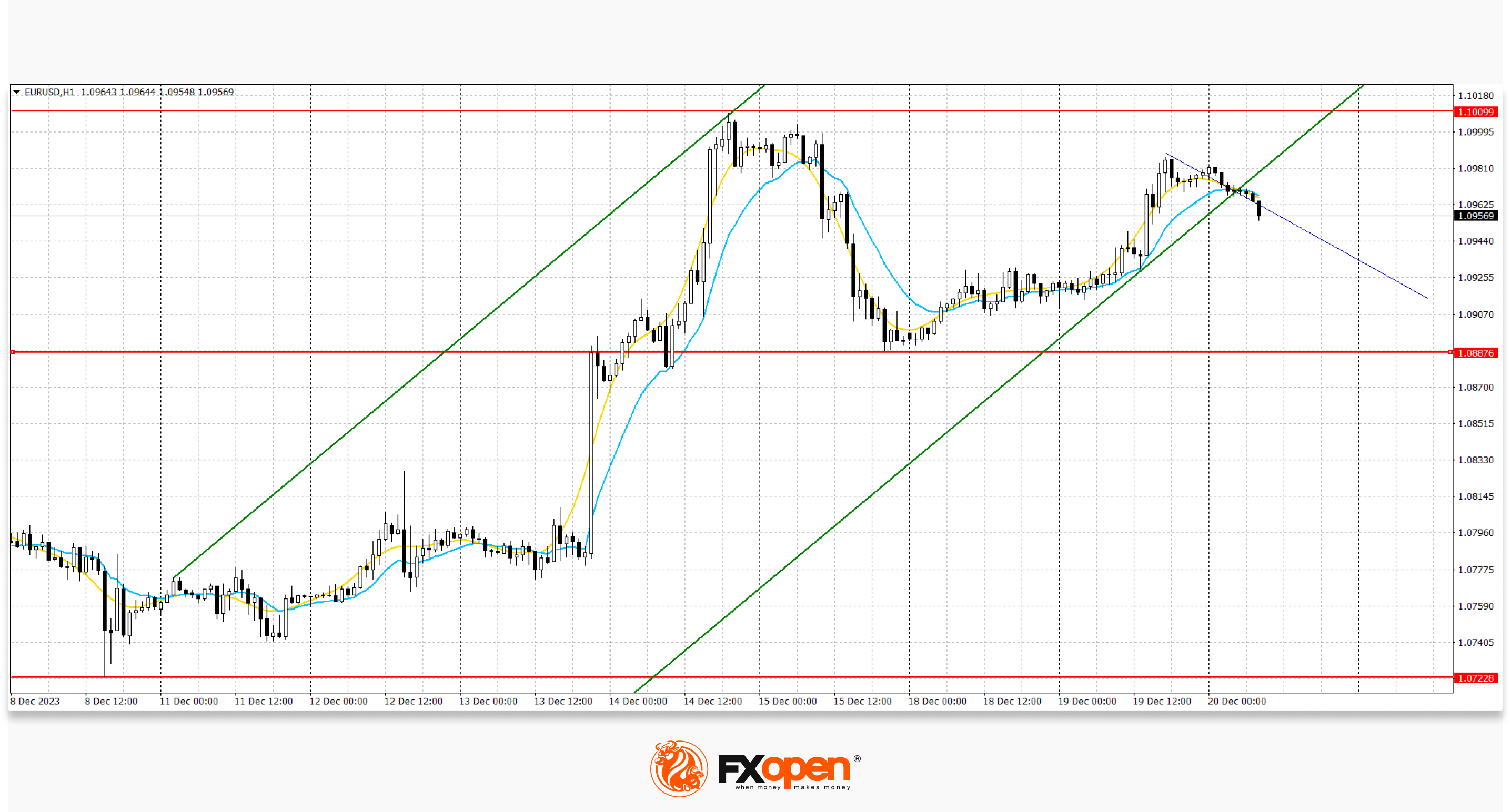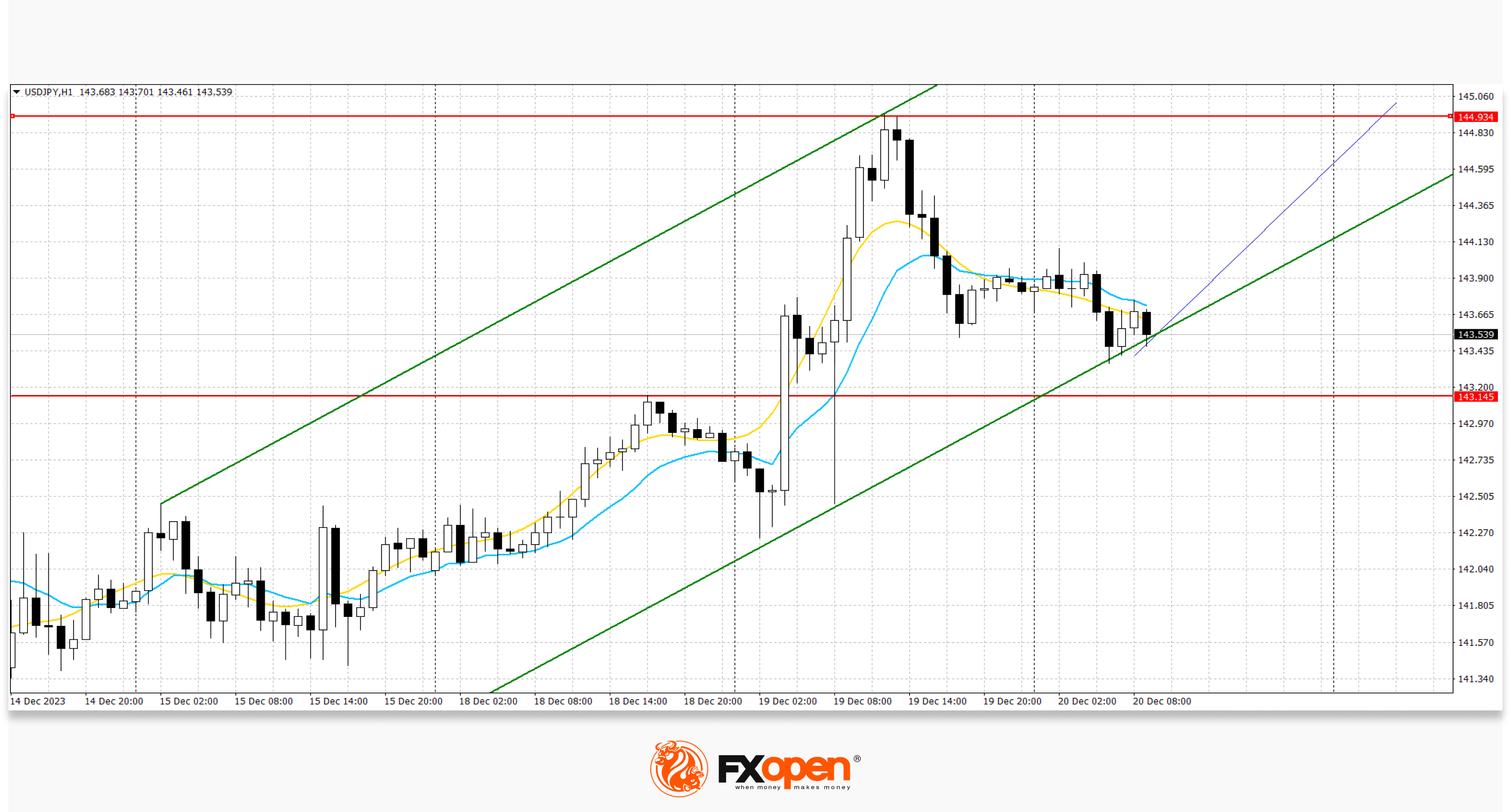FXOpen

EUR/USD
The EUR/USD pair shows a moderate decline, correcting after active growth the day before, which allowed the local highs of December 15 to be updated. According to the EUR/USD technical analysis, immediate resistance can be seen at 1.1023, a break higher could trigger a rise towards 1.1100. On the downside, immediate support is seen at 1.0893, a break below could take the pair towards 1.0845.
The focus of trading participants is the November inflation data in the eurozone. The consumer price index fell from 0.1% to -0.6%, reaching negative territory for the first time since June. The base rate fell from 0.2% to -0.6% on a monthly basis, and from 4.2% to 3.6% on an annualised basis. Inflationary pressures continue to weaken, but the ECB is likely to begin easing monetary policy only after the negative dynamics become sustainable.
Today, investors will focus on statistics on consumer confidence in Germany. A slight increase in the indicator is expected from -27.8 points to -27.0 points. Also during the day, November data on manufacturing inflation will be presented. Analysts expect the producer price index to contract by 0.3% after -0.1% in the previous month, and in annual terms the figure could adjust from -11.0% to -7.5%. In addition, a monthly report from the German Bundesbank will be published today, which may clarify forecasts for economic growth and inflation dynamics in the near future.

The price has broken through the lower boundary of the ascending channel and may continue to decline.
GBP/USD
On the GBP/USD chart, the pair is showing a decline after yesterday's rise to 1.2760. Immediate resistance can be seen at 1.2741, a break higher could trigger a rise towards 1.2786. On the downside, immediate support is seen at 1.2616, a break below could take the pair towards 1.2590.
The pound rose on Tuesday as investors increasingly viewed sterling as a promising currency for next year. The pound has risen about 2.5% over the past three months as optimism increased that the US Federal Reserve will soon cut rates. Investors are now expecting around 120 basis points of rate cuts from the Bank of England next year and nearly 150 basis points from the Fed.
UK inflation data for November will be published on Wednesday before traders head off for the Christmas holidays. Headline inflation is expected to slow to 4.4% year on year from 4.6% in October. Inflation is now higher than in the US or eurozone, where in November it was 3.1% and 2.4%, respectively. This is one of the reasons why the Bank of England abandoned expectations of a rate cut last week.

The price has broken through the lower boundary of the ascending channel and may continue to decline.
USD/JPY
On the USD/JPY chart, the pair again shows a corrective decline, testing the 143.50 mark for a breakdown downwards. Strong resistance can be seen at 144.33, a break higher could trigger a rise towards 145.08. On the downside, immediate support is seen at 142.50. A break below could take the pair towards 141.21.
The day before, the pair showed active growth, reacting to the dovish rhetoric of the Bank of Japan. The target short-term rate was kept at -0.10%, and the 10-year government bond yield was kept at around 0.0%. At the same time, markets still expect significant changes in the vector of the regulator’s monetary policy next year. Regulator officials decided to wait for additional macroeconomic data on wage dynamics, despite the fact that trade unions and large companies are signalling a positive trend that is likely to continue into next year.
More than 80.0% of economists surveyed by Reuters expect the Bank of Japan to end its negative interest rate policy in 2024, with half of them predicting the first changes to the parameters will be made as early as April. Today, November foreign trade statistics were presented in Japan. The trade deficit increased from 661.0 billion yen to 776.9 billion yen, which, however, was better than expected at 962.4 billion yen. On Friday, traders will pay attention to November data on the national consumer price index: forecasts suggest a slowdown in the indicator excluding food from 2.9% to 2.5%.

Based on the highs of two days, a new ascending channel has formed. Now the price is near the lower border of the channel and may continue to rise.
Trade over 50 forex markets 24 hours a day with FXOpen. Take advantage of low commissions, deep liquidity, and spreads from 0.0 pips. Open your FXOpen account now or learn more about trading forex with FXOpen.
This article represents the opinion of the Companies operating under the FXOpen brand only. It is not to be construed as an offer, solicitation, or recommendation with respect to products and services provided by the Companies operating under the FXOpen brand, nor is it to be considered financial advice.
Stay ahead of the market!
Subscribe now to our mailing list and receive the latest market news and insights delivered directly to your inbox.








